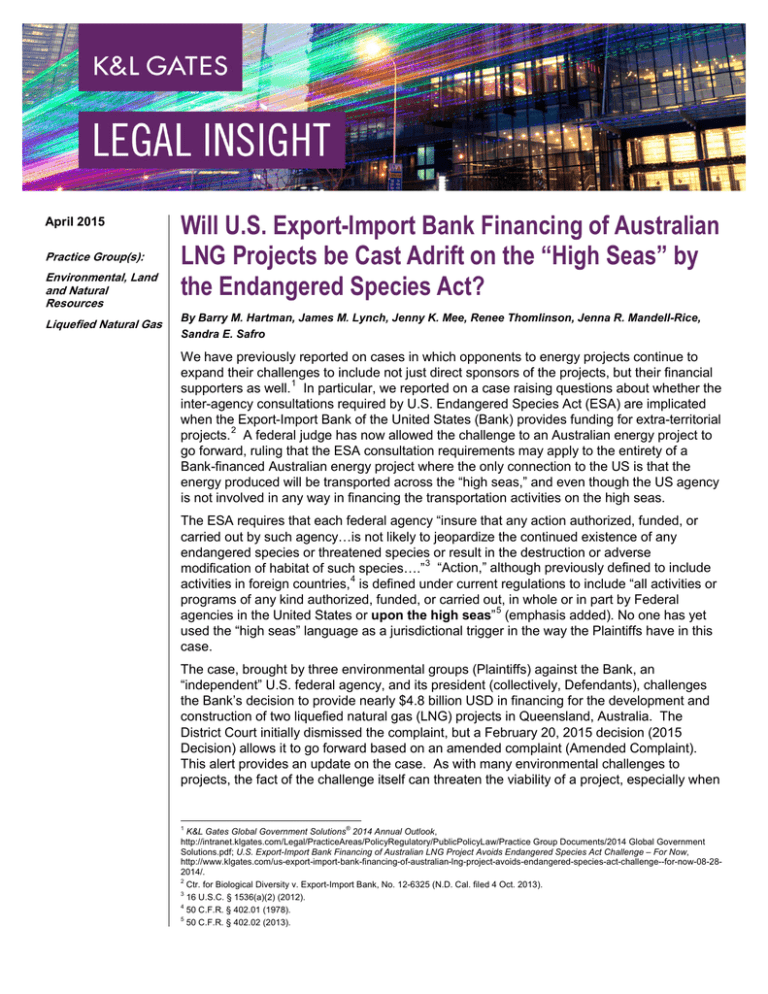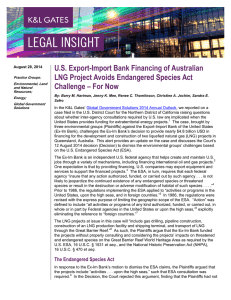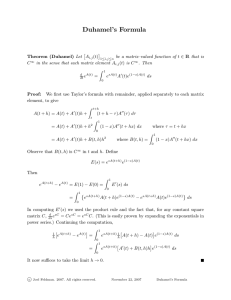
April 2015
Practice Group(s):
Environmental, Land
and Natural
Resources
Liquefied Natural Gas
Will U.S. Export-Import Bank Financing of Australian
LNG Projects be Cast Adrift on the “High Seas” by
the Endangered Species Act?
By Barry M. Hartman, James M. Lynch, Jenny K. Mee, Renee Thomlinson, Jenna R. Mandell-Rice,
Sandra E. Safro
We have previously reported on cases in which opponents to energy projects continue to
expand their challenges to include not just direct sponsors of the projects, but their financial
supporters as well. 1 In particular, we reported on a case raising questions about whether the
inter-agency consultations required by U.S. Endangered Species Act (ESA) are implicated
when the Export-Import Bank of the United States (Bank) provides funding for extra-territorial
projects. 2 A federal judge has now allowed the challenge to an Australian energy project to
go forward, ruling that the ESA consultation requirements may apply to the entirety of a
Bank-financed Australian energy project where the only connection to the US is that the
energy produced will be transported across the “high seas,” and even though the US agency
is not involved in any way in financing the transportation activities on the high seas.
The ESA requires that each federal agency “insure that any action authorized, funded, or
carried out by such agency…is not likely to jeopardize the continued existence of any
endangered species or threatened species or result in the destruction or adverse
modification of habitat of such species….”3 “Action,” although previously defined to include
activities in foreign countries, 4 is defined under current regulations to include “all activities or
programs of any kind authorized, funded, or carried out, in whole or in part by Federal
agencies in the United States or upon the high seas” 5 (emphasis added). No one has yet
used the “high seas” language as a jurisdictional trigger in the way the Plaintiffs have in this
case.
The case, brought by three environmental groups (Plaintiffs) against the Bank, an
“independent” U.S. federal agency, and its president (collectively, Defendants), challenges
the Bank’s decision to provide nearly $4.8 billion USD in financing for the development and
construction of two liquefied natural gas (LNG) projects in Queensland, Australia. The
District Court initially dismissed the complaint, but a February 20, 2015 decision (2015
Decision) allows it to go forward based on an amended complaint (Amended Complaint).
This alert provides an update on the case. As with many environmental challenges to
projects, the fact of the challenge itself can threaten the viability of a project, especially when
1
K&L Gates Global Government Solutions® 2014 Annual Outlook,
http://intranet.klgates.com/Legal/PracticeAreas/PolicyRegulatory/PublicPolicyLaw/Practice Group Documents/2014 Global Government
Solutions.pdf; U.S. Export-Import Bank Financing of Australian LNG Project Avoids Endangered Species Act Challenge – For Now,
http://www.klgates.com/us-export-import-bank-financing-of-australian-lng-project-avoids-endangered-species-act-challenge--for-now-08-282014/.
2
Ctr. for Biological Diversity v. Export-Import Bank, No. 12-6325 (N.D. Cal. filed 4 Oct. 2013).
3
16 U.S.C. § 1536(a)(2) (2012).
4
50 C.F.R. § 402.01 (1978).
5
50 C.F.R. § 402.02 (2013).
Will U.S. Export-Import Bank Financing of Australian LNG Projects be Cast
Adrift on the “High Seas” by the Endangered Species Act?
the ESA is implicated, since it is one of the few laws that can literally stop a project in its
tracks.
The Original Case and the 2014 Dismissal
Each of the Australian LNG projects at issue consists of (1) an upstream portion, including
gas drilling and pipeline construction to transport gas to the coast, and (2) a downstream
portion, including the construction of a LNG production facility and shipping terminal on
Curtis Island to process the gas and dredging of the adjacent harbor to facilitate tanker
access. The Plaintiffs allege that shipping of the final product across the high seas, destined
primarily for Asian ports, but in some cases, western ports and the Americas, is also part of
each project. 6 It is foreseeable that such shipping may take place towards the middle of this
year. 7 The Bank financed the construction of two LNG production facilities and related
infrastructure, including two marine jetties and loading berths to transfer LNG to tankers for
shipping. 8 In the August 12, 2014, decision (2014 Decision), the District Court dismissed
Plaintiffs’ ESA claims, finding that the facts asserted in the complaint did not allege that the
projects took place on the “high seas” and, therefore, that the Plaintiffs failed to allege facts
sufficient to suggest that the consultation obligations under Section 7(a)(2) of the ESA were
triggered. 9 In particular, the Court found that Plaintiffs failed to allege facts adequate to
suggest the transportation of LNG is part of the projects funded by the Bank.10
The Amended Complaint
Plaintiffs amended their complaint to claim that the projects would include shipping of the
final LNG product and that this was enough to trigger ESA review under the “high seas”
language. 11 As support for their assertion, Plaintiffs cite to the draft environmental
assessment, required by the Queensland Government’s State Development and Public
Works Organisation Act 1971, for the Queensland Curtis LNG project. 12 The Amended
Complaint then alleges that a similar type of environmental assessment was prepared for the
Australia Pacific LNG project that indicates the project proponents will work to set certain
navigational requirements applicable to ships accessing the LNG facility and that the
project proponents may be responsible for securing ships for delivery under certain
circumstances. 13 Plaintiffs consequently maintain that shipping operations and the
transportation of LNG are components of the projects and trigger ESA review.
Defendants subsequently filed a motion to dismiss,14 again asserting that the Plaintiffs failed
to allege sufficient facts to allow the Court to draw the reasonable inference that the Bank
violated the ESA by failing to consult with the Secretary prior to approving loans for the
projects because the projects did not take place in the United States or on the high seas.
The Bank further argued that even if projects involved shipping on the high seas, the Bank
did not provide funding for those portions of the projects.
6
Second Amended Complaint, Ctr. for Biological Diversity, No. 12-6325, ECF No. 64, ¶¶ 2-3 (Amended Complaint).
On February 11, 2015, one of the projects reached a significant milestone with the arrival of the first gas from its coal seam gas fields to
its LNG facility on Curtis Island. This marked the completion of the commissioning of the gas pipeline and will keep the project on track for
delivering the first LNG in mid-2015.
8
Ctr. for Biological Diversity, No. 12-6325 at 11.
9
Order Granting Motion to Dismiss, Ctr. for Biological Diversity, No. 12-6325, ECF No. 62 at 8 (12 Aug. 2014).
10
Id.
11
Amended Complaint ¶¶ 2–3.
12
Amended Complaint ¶¶ 98–99.
13
Id. ¶¶ 85–86.
14
Motion to Dismiss, Ctr. for Biological Diversity, No. 12-6325, ECF No. 69.
7
2
Will U.S. Export-Import Bank Financing of Australian LNG Projects be Cast
Adrift on the “High Seas” by the Endangered Species Act?
The 2015 Decision
In the 2015 Decision, the District Court found that the Plaintiffs had alleged facts that, if true,
were sufficient to support the inference that the scope of Bank’s action included shipping on
the high seas, and therefore, the Plaintiffs had alleged sufficient facts to state a claim for
relief under the ESA. 15 The Court noted that the Bank provided funding for “downstream”
portions of the projects, “specifically, financing for construction of two LNG facilities and
related infrastructure,” but acknowledged that the Bank did not specifically provide financing
for post-construction shipping activities, including the activities claimed in the Amended
Complaint to create the nexus to the high seas (navigational requirements and securing
ships). 16 However, the Court explained that, although the Bank only provided funding for
construction, the LNG facilities will be constructed and operated for the purpose “of
producing, storing and exporting LNG” 17 and that it is “reasonable to infer that exporting
LNG to destinations abroad is one of the primary objectives/components of the project.” 18
According to the District Court, the Amended Complaint strengthened the Plaintiffs’ case by
alleging facts about each project as a whole, and not just the specific components of the
projects funded by the Bank.
The next step will be for the Plaintiff’s to prove the inference that the District Court permitted
to be drawn from the Amended Complaint, that shipping on the high seas is part of the
projects. If the Plaintiffs can successfully do so, then the extraterritorial application of the
ESA may be broadened considerably. Either way, the 2015 Decision may signal a new effort
to trigger the ESA consultation process for projects wholly outside US borders, even where
the actual activity funded or authorized by the agency does not directly take place on the
high seas. In addition to potentially expanding the geographic reach of the ESA, the District
Court’s decision on Plaintiffs’ claim that the Bank “failed to prepare a biological assessment
describing the impacts of the Australia Pacific and Queensland Curtis LNG Projects on
endangered species,” means that the Bank may now have to prepare a biological
assessment for each project as a whole, including the upstream portions and the shipping
activities, and not just the portion of the project that it funded. The mere fact that this kind of
tenuous connection might trigger the ESA needs to be taken into account by those involved
in planning these projects.
In reaching its decision, the Court relied on two cases, Conner v. Burford 19 and Defenders of
Wildlife v. U.S. Department of the Navy.20 In both cases, the courts were addressing the
scope of activities that needed to be assessed in a biological assessment under the ESA, but
did not question whether the agency action came under the jurisdiction of the ESA. The
2015 Decision may represent the potential extension of the precedents under these cases to
an entirely different factual scenario. In Burford, the court held that a biological opinion
prepared for oil and gas leases must cover not only the leasing itself but also all post-leasing
activities through production and abandonment. In Navy, the plaintiffs asserted that a
biological opinion assessing the installation and operation of a training range must consider
15
Order Denying Motion to Dismiss, Ctr. for Biological Diversity, No. 12-6325, ECF No. 75 at 8 (20 Aug. 2015).
Id. at 11.
17
Id.
18
Id.
19
848 F.2d 1441 (9th Cir. 1988).
20
733 F.3d 1106 (11th Cir. 2013).
16
3
Will U.S. Export-Import Bank Financing of Australian LNG Projects be Cast
Adrift on the “High Seas” by the Endangered Species Act?
both the effects of the installation and the ongoing operations. The court noted that “the rule
that biological opinions must be coextensive in scope with the ‘entire action’ or else violate
the ESA is nowhere to be found in the language of the ESA” and declined to adopt that rule,
but found that as a factual matter the biological opinion analyzed both installation and
operations and was therefore “coextensive in scope.” Neither case extended agency
obligations under the ESA to the transportation segment of a project where the agency had
no actual, financial or other involvement in any aspect of transportation of products from the
covered project.
What Might this Mean?
Despite the lack of clear precedent on this issue, the 2015 Decision may result in each
project as a whole, and not just the portion directly funded by the agency, being subject to
ESA Section 7 review. Proponents for foreign LNG and other agency financed projects may
now need to consider whether any other components of a larger project related to the
agency action may take place on the high seas or whether achievement of the project’s
greater purpose or objective may require use of the high seas and, therefore, potentially
trigger ESA Section 7 consultation, even if the agency is not directly involved in such
component.
Authors:
James M. Lynch
jim.lynch@klgates.com
+1.206.370.6587
jenny.mee@klgates.com
+61.2.9513.2555
Renee Thomlinson
Jenna R. Mandell-Rice
Sandra E. Safro
renee.thomlinson@klgates.com
+61.2.9513.2437
jenna.mandell-rice@klgates.com
+1.202.778.9315
sandra.safro
+1.202.778.9178
Barry M. Hartman
barry.hartman@klgates.com
+1.202.778.9338
Jenny K. Mee
Anchorage Austin Beijing Berlin Boston Brisbane Brussels Charleston Charlotte Chicago Dallas Doha Dubai Fort Worth Frankfurt
Harrisburg Hong Kong Houston London Los Angeles Melbourne Miami Milan Moscow Newark New York Orange County Palo Alto Paris
Perth Pittsburgh Portland Raleigh Research Triangle Park San Francisco São Paulo Seattle Seoul Shanghai Singapore Spokane
Sydney Taipei Tokyo Warsaw Washington, D.C. Wilmington
K&L Gates comprises more than 2,000 lawyers globally who practice in fully integrated offices located on five continents.
The firm represents leading multinational corporations, growth and middle-market companies, capital markets
participants and entrepreneurs in every major industry group as well as public sector entities, educational institutions,
philanthropic organizations and individuals. For more information about K&L Gates or its locations, practices and
registrations, visit www.klgates.com.
This publication is for informational purposes and does not contain or convey legal advice. The information herein should not be used or relied upon in regard to any particular facts or
circumstances without first consulting a lawyer.
© 2015 K&L Gates LLP. All Rights Reserved.
4





